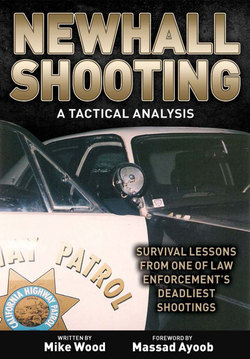Читать книгу Newhall Shooting - A Tactical Analysis - Michael E. Wood - Страница 8
На сайте Литреса книга снята с продажи.
ОглавлениеSECTION ONE
The Shooting
Introduction
The following narrative of the Newhall shooting1 is drawn from multiple sources, including interviews with participants, a thorough examination of the homicide investigation files completed and maintained by the Los Angeles County Sheriff’s Department, and official California Highway Patrol (CHP) documents, photographs, and film.
Unfortunately, the reconstruction of a complex event is often limited by the fallible memories of the participants and witnesses. It’s a matter of extensive research, investigation, and discussion within medical and legal circles that witnesses often don’t remember the details of an event, particularly a dramatic and life-threatening event such as a gunfight, with total accuracy.2 Since a memory is “a record of people’s experiences of events, not a record of those events themselves,” it is bound to be influenced by a host of physical, spatial, cognitive, environmental, and emotional factors that affect those personal experiences and place their own imprints on the individuals’ perception of the true action that occurred.3 This leads to the inevitable result of conflicting testimony and complicates the investigator’s and author’s task of understanding the incident as it truly happened.
This general tendency is made even worse by the nature of a large-scale gunfight such as the Newhall shooting, because the action is fast, dispersed, and constant, and because multiple storylines are being played out simultaneously in a way that none of the participants or witnesses can actively track each of them with any fidelity as they occur. Gunfights are not tidy, linear actions that can be neatly recreated in sequence, but rather messy, confused events in which the participants are keenly aware of their immediate situation, but largely unaware of their place in the larger picture.
This is certainly the case in the Newhall shooting. While the general narrative is agreed upon, there are certain aspects of the event for which information is not clear. The physical evidence is incomplete, and witnesses provided conflicting testimony about various aspects of the shooting. While we can hazard our best guess of the situation, based on known evidence and a preponderance of testimony, we may never know exactly what happened during portions of this fluid, fast-paced action. The task of recreating the sequence of the Newhall shooting is further complicated by the fact that five of the seven principal players were killed during or shortly after the incident occurred. Fortunately, there are also many factors that helped to mitigate these concerns.
To begin with, there was a large number of witnesses to the event, as it occurred in a brightly lit area within the visual range of a parking lot and restaurant full of people.4 The volume of reports allowed investigators to separate the wheat from the chaff and assemble a reasonably consistent picture of the events as they took place.
One of the perpetrators, Jack Twining, spoke to Los Angeles County Sheriff’s Department personnel via phone during the hostage crisis that ensued as he attempted his escape from the scene of the shooting. He also discussed the shooting via monitored phone call with his partner, Bobby Davis, who had been captured and was in Sheriff’s custody. Lastly, Twining completed a phone interview with media personnel (which was monitored by law enforcement), prior to his suicide.5 During these conversations, Twining recounted valuable details about the shooting, which assisted investigators in their reconstruction efforts. The other perpetrator, Bobby Davis, also provided information to investigators in the wake of his capture, interrogation, and trial.
The civilian hero of the shooting, Gary Dean Kness, also provided vital firsthand knowledge of a portion of the events. As an active participant in the gunfight, Mr. Kness was certainly subject to a host of physiological reactions that might have affected his memory of the events, but as the only surviving close range witness to some of the happenings, his testimony was critical to a complete understanding of some of the most desperate moments of the battle.
Besides witness testimony, the shooting investigation team had a host of physical evidence to draw upon as it prepared its reconstruction of the shooting. Much of this evidence has been well preserved and was still accessible during research for this project. Some of the evidence was incomplete from the beginning (such as the information on the number of shots fired during the incident), but we are fortunate that the majority of the physical evidence was properly documented and preserved.6
With these limitations in mind, the following narrative represents the most comprehensive, accurate account of this watershed event to date. Where inconsistencies or unknowns exist, they will be recognized and explained to the best extent possible.
